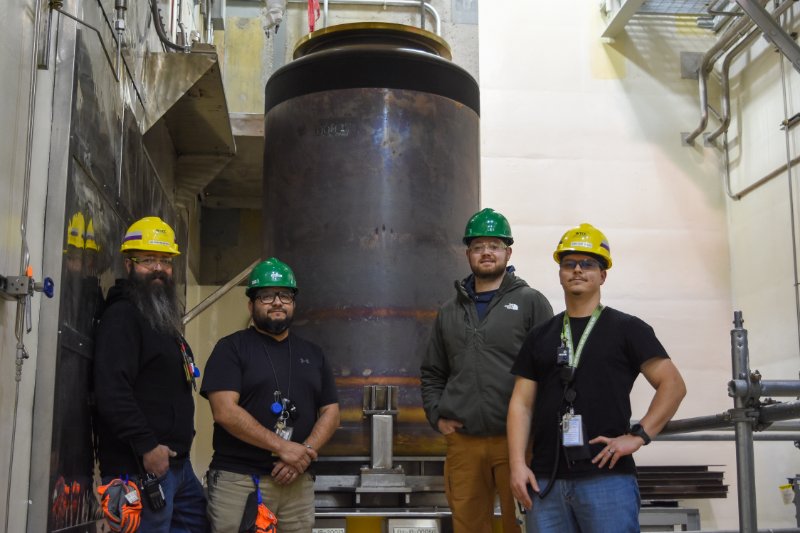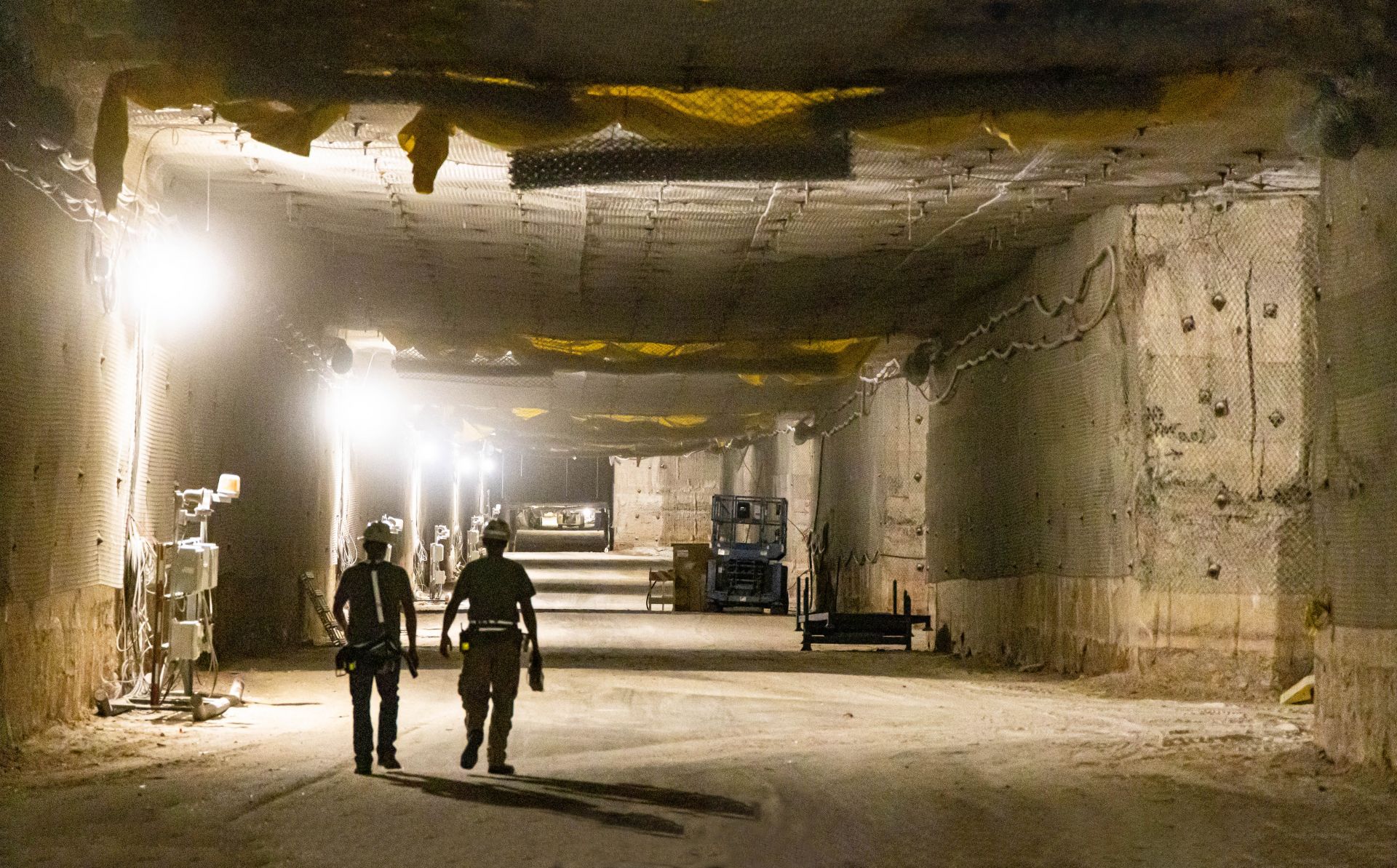Vit Plant crews begin adding frit into Hanford’s second melter. (Photo: Bechtel National)
The Department of Energy’s Office of Environmental Management recently announced that crews at the Hanford Site’s Waste Treatment and Immobilization Plant, also known as the Vit Plant, recently brought the second of two 300-ton melters up to the operating temperature of 2,100°F.
A screen shot of a video marking the 25th anniversary of operations at the WIPP disposal facility. (Image: DOE)
The Department of Energy’s Office of Environmental Management celebrated a major milestone for the Waste Isolation Pilot Plant last week, marking the 25th anniversary of the receipt of the first waste shipment at the disposal facility in New Mexico’s Chihuahuan Desert.
One of 18 startup heaters is installed in Hanford’s second melter, which will be used to vitrify liquid waste. (Photo: DOE)
The Department of Energy’s Office of Environmental Management announced that crews at the Hanford Site’s Waste Treatment and Immobilization Plant, also known as the Vit Plant, recently installed 18 temporary startup heaters in the second of two melters in the plant’s Low-Activity Waste Facility.
A waste transport delivery truck heads for the WIPP site in New Mexico. In 2023, the repository saw its best shipment performance in 10 years. (Photo: DOE)
The Department of Energy’s Office of Environmental Management announced last week that, for calendar year 2023, the department’s Waste Isolation Pilot Plant (WIPP) had its best shipment performance in 10 years, having received 489 transuranic (TRU) waste shipments from generator sites throughout the country. For comparison, WIPP received only 272 shipments in 2022.
Nukem’s waste solidification plant mock-up. (Photo: Nukem Technologies)
Nukem Technologies, a German-based radioactive waste management company, announced last week that it has successfully completed a mock-up for a state-of-the-art waste solidification plant. The plant will use the in-drum cementation process for encapsulating various types of radioactive waste into a solid, secure form suitable for long-term storage.
A continuous miner machine cuts into salt rock as mining begins on Panel 11, one of WIPP’s next waste disposal panels. (Photo: DOE)
For the first time in a decade, crews have started mining a new disposal panel at the Department of Energy’s Waste Isolation Pilot Plant (WIPP) in New Mexico, the nation’s deep geologic waste repository for defense-related transuranic waste.
Concept art of the Chalk River near surface disposal facility for LLW. (Image: CNL)
The Canadian Nuclear Safety Commission has decided to amend Canadian Nuclear Laboratories’ operating license for the Chalk River Laboratories, allowing the construction of a near surface disposal facility (NSDF) for low-level radioactive waste on the nuclear research site in Deep River, Ontario.
A view of two vessels that each contain approximately 30,000 pounds of granulated activated carbon, used to remove mercury from process off-gas during IWTU operations. (Photo: DOE)
The Department of Energy’s Office of Environmental Management said Idaho’s Integrated Waste Treatment Unit (IWTU) is set to resume radioactive liquid waste treatment operations early next year after crews replaced carbon material from two plant vessels. The IWTU was shut down for an unplanned outage on September 6 to address elevated mercury concentrations in the plant’s granulated activated carbon (GAC) beds, according to Defense Nuclear Facilities Safety Board (DNFSB) reports.
Operators in plastic suits prepare for drum venting operations. (Photo: DOE/SRNS)
Department of Energy contractor Savannah River Nuclear Solutions (SRNS) said its Savannah River Site employees recently used an innovative method to ensure the integrity of radioactive material storage containers currently in long-term dry storage at the South Carolina site.
Crewmembers stand in front of the first stainless-steel container filled with molten test glass at Hanford’s Vit Plant. (Photo: Bechtel National)
Bechtel and the Department of Energy’s Office of Environmental Management announced on December 4 that the first set of test glass was successfully poured into a stainless-steel storage container designed to hold vitrified waste at Hanford’s Waste Treatment and Immobilization Plant, also known as the Vit Plant.
Electrical circuits are tested during the commissioning of the new ventilation system at WIPP. (Photo: DOE)
Commissioning has begun on a new large-scale ventilation system at the Waste Isolation Pilot Plant in New Mexico.
The Safety Significant Confinement Ventilation System (SSCVS) is expected to increase underground airflow from 170,000 cubic feet per minute up to 540,000 cfm. The increased airflow will allow for simultaneous underground waste emplacement, mining, and ground control work. Ground control, including bolting, controls the movement of salt rock—known as salt creep—in the WIPP underground.
Workers monitor the pouring of melter glass from a control room in Hanford’s LAW Facility. (Photo: DOE)
The Department of Energy’s Office of Environmental Management said crews at its Hanford Site in Washington state have started pouring the first molten glass from a waste vitrification melter into a stainless steel container at the site’s Waste Treatment and Immobilization Plant, also known as the Vit Plant.
Workers walk down an underground passageway at the Waste Isolation Pilot Plant transuranic waste repository in New Mexico. (Photo: DOE)
The American Nuclear Society coordinated an effort with eight nongovernmental organizations in asking Congress to update the Environmental Protection Agency’s generic standards for the safe, permanent disposal of spent nuclear fuel (SNF) and high-level radioactive waste.













